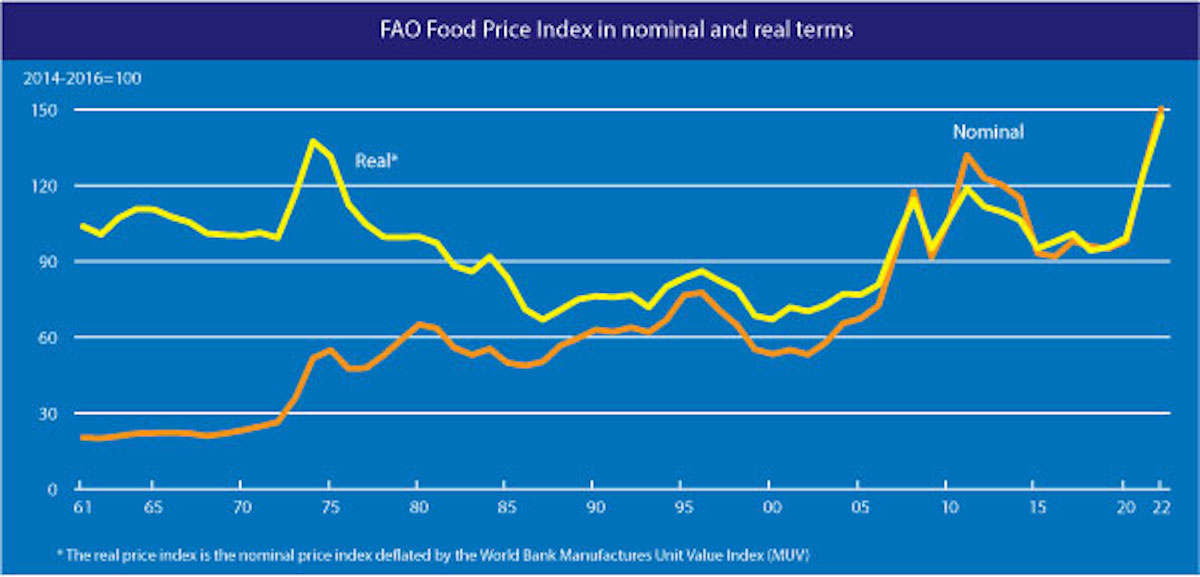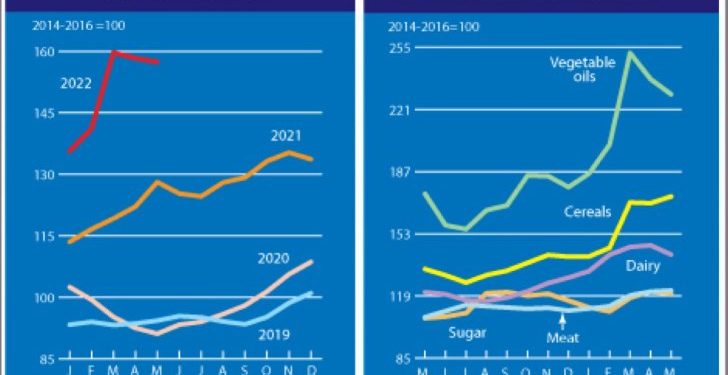The FAO Food Price Index* (FFPI) averaged 157.4 points in May 2022, down 0.9 points (0.6 percent) from April, marking the second consecutive monthly decline, though still 29.2 points (22.8 percent) above its value in the corresponding month last year.
The drop in May was led by declines in the vegetable oil and dairy price indices, while the sugar price index also fell to a lesser extent. Meanwhile, cereal and meat price indices increased.
The FAO Cereal Price Index averaged 173.4 points in May, up 3.7 points (2.2 percent) from April and as much as 39.7 points (29.7 percent) above its May 2021 value.
International wheat prices rose for a fourth consecutive month, up 5.6 percent in May, to average 56.2 percent above their value last year and only 11 percent below the record high reached in March 2008.
The steep increase in wheat prices was in response to an export ban announced by India amidst concerns over crop conditions in several leading exporting countries, as well as reduced production prospects in Ukraine because of the war.
By contrast, international coarse grain prices declined by 2.1 percent in May but remained 18.1 percent above their value a year ago. Slightly improved crop conditions in the United States of America, seasonal supplies in Argentina and the imminent start of Brazil’s main maize harvest led maize prices to decline by 3.0 percent; however, they remained 12.9 percent above their level of May 2021.
Similarly, international sorghum prices also fell in May, declining by 3.1 percent, while spillover from the strength in wheat markets and concerns over crop conditions in the European Union boosted barley prices by 1.9 percent.
International rice prices increased for the fifth successive month in May. Quotations strengthened in all the major market segments, but monthly increases were least pronounced (2.6 percent) for the most widely traded Indica varieties, amid ample supplies, especially in India.
The FAO Vegetable Oil Price Index averaged 229.3 points in May, down 8.3 points (3.5 percent) month-on-month, yet remaining markedly above its year-earlier level. The monthly decline mainly reflects lower prices across palm, sunflower, soy, and rapeseed oils.
International palm oil prices weakened moderately in May. Apart from demand rationing, the removal of Indonesia’s short-lived export ban on palm oil exerted additional downward pressure on prices, although a further price drop was contained by lingering uncertainties over the country’s export prospects.
Meanwhile, world price quotations for sunflower oil fell from recent record highs, with stocks continuing to accumulate in Ukraine owing to logistical bottlenecks.
International soy and rapeseed oil prices also declined somewhat in May, chiefly weighed by sluggish import demand in view of elevated costs in recent months.
The FAO Dairy Price Index averaged 141.6 points in May, down 5.1 points (3.5 percent) from April, marking the first decline after eight consecutive monthly increases, but still 20.5 points (16.9 percent) higher than its level in May of last year.
World prices of all milk products fell, with milk powders declining the most, underpinned by lower buying interests on market uncertainties stemming from the continued lockdown in China, despite the persistent global supply tightness.
Butter prices also dropped significantly due to weaker import demand in tandem with some improvements to supplies from Oceania and limited internal sales in Europe.
Meanwhile, robust retail sales and high demand from restaurants ahead of the summer holidays in the Northern Hemisphere prevented cheese prices from falling significantly, despite weakened global import demand.
The FAO Meat Price Index* averaged 122.0 points in May, up 0.6 points (0.5 percent) from April, setting a new all-time high, driven by a steep rise in world poultry meat prices, more than offsetting declines in pig and ovine meat values.
In May, poultry meat prices rose, reflecting the continued supply chain disruptions in Ukraine and recent cases of avian influenza amid a surge in demand in Europe and the Middle East.
Meanwhile, international bovine meat prices remained stable, as increased supplies from Brazil and Oceania were adequate to meet persistently high global demand.
By contrast, world pig meat prices fell on high export availabilities, especially in Western Europe, amid lacklustre internal demand and expectations for releasing pig meat from the EU Commission’s Private Storage Aid scheme.
International prices of ovine meat also dropped, reflecting the impact of currency movements.
The FAO Sugar Price Index averaged 120.3 points in May, down 1.3 points (1.1 percent) from April, marking the first decline after sharp increases registered in the previous two months.
The recent monthly decline in international sugar price quotations was triggered by limited global import demand and good global availability prospects, mostly stemming from a bumper crop in India.
The weakening of the Brazilian Real against the US dollar and lower ethanol prices resulted in further downward pressure on world sugar prices.
However, uncertainties over the current season’s outturn in Brazil, the world’s largest sugar exporter, prevented more substantial price declines.
* Unlike for other commodity groups, most prices utilized in the calculation of the FAO Meat Price Index are not available when the FAO Food Price Index is computed and published; therefore, the value of the Meat Price Index for the most recent months is derived from a mixture of projected and observed prices. This can, at times, require significant revisions in the final value of the FAO Meat Price Index which could in turn influence the value of the FAO Food Price Index.









